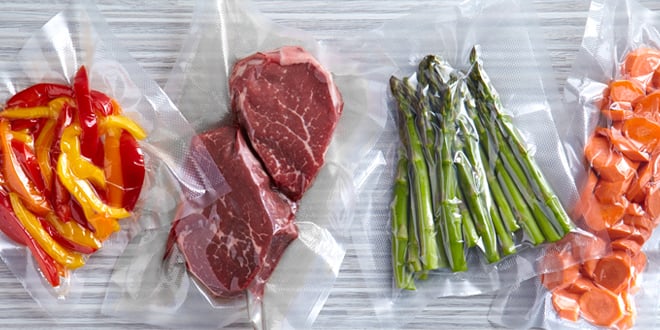UPDATED April 3, 2020: Vacuum sealing food is a great way to keep food fresh longer, while ultimately helping you save a little cash. Whether you are buying chicken breasts in bulk when they are on sale at the grocery store or storing dry beans and coffee grounds in the pantry, vacuum sealing is a great way to store food and preserve freshness.
A vacuum sealer quickly takes the air out of a bag and then heat seals it, creating an airtight, permanent seal that preserves freshness and prevents freezer burn.
Meat
Vacuum sealing meats is extremely common. You might find chicken or pork on sale at the store and decide to buy in bulk. Use what you need for dinner that night then vacuum seal the rest. Either put it in the fridge if you are going to use it later that week, or throw it in the freezer to use at a later time.
Vegetables
Vacuum sealing is another great way to preserve seasonal vegetables. Do you have a vegetable garden but you just can’t seem to eat or cook all of the bounty? Vacuum seal your vegetables and use them later. You will want to wash then blanch the vegetables before vacuum sealing them and store them in the freezer until it’s time to use them. You definitely don’t want all of those delicious summer vegetables to go to waste.
Meal Prep
While vacuum sealers are great for storing and preserving, they are also a great tool for meal prep. For example, you can make slow cooker stuffed mozzarella meatballs one night for dinner and vacuum seal any leftovers for another night. Then, whenever you are craving a hearty meal, the meatballs are ready and waiting for you in the freezer. All you have to do is to do is pop them in the slow cooker with some marinara sauce and let them heat through. Dinner was ready in no time. Who doesn’t appreciate convenience on a busy weeknight?
Bulk Ingredients
For those of you who appreciate a clean and organized space, vacuum sealers might become your new best friend. You’ve seen those large storage containers in people’s pantries before, right? Instead of filling them up halfway with dry beans, coffee grounds, or rice, why not vacuum seal your dry ingredients? Not only will they take up less space in your pantry, they will stay fresh longer too.
Sous Vide
If you love cooking sous vide, or are interested in getting started, a vacuum sealer is a great place to start. “Sous vide” is a French term that literally means “under vacuum” and is a no-fail cooking method that uses a heated water bath to cook sealed food evenly and to a precise temperature. Because you are submerging food into a water bath to cook, you must first seal your ingredients. While you can use a plastic bag, vacuum sealing the food is recommended for best results – that way you ensure that the food and seasoning will not leak out and water will not creep in during the cooking process.
Vacuum Sealer Bags
A vacuum sealer quickly takes the air out of a bag and then heat seals it, creating an airtight, permanent seal that preserves freshness and prevents freezer burn. By locking this freshness in, you can store your food in the pantry, refrigerator or freezer. You can find heat-sealing bags conveniently pre-sized or in a roll if you like the versatility of creating sizes to meet you specific needs. This NutriFresh™ Vacuum Sealer is even equipped with built-in roll storage and cutter to make life one step easier.
Learn more about NutriFresh Vacuum Sealers and the advantages of using one.
How do you use your vacuum sealer? Let us know in the comments below.






Have yet to find a vacuum sealer that works well. I have however learned quite a few great tips on using them! Any suggestions on a good sealer welcomed! 😊
We’re so glad you found this article helpful! You can shop the Hamilton Beach vacuum sealers here >> https://www.hamiltonbeach.com/vacuum-sealers-bags
I use my sealer to re-seal cereal and potato chip bags — sealer only, no vacuum. Works wonderfully well and keeps my pantry items fresh longer. Well worth the expense just for that. I also sometimes use it for small amounts of leftovers, like spaghetti, chili, taco meat. Small amounts can be vacuum sealed and frozen, then re-heated for individual lunches!
This could be real handy for a single person. (ME)
They all look amazing